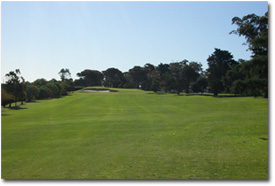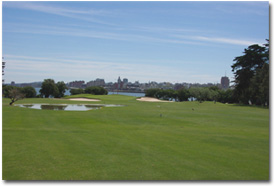Featured Golf News
MacKenzie in Uruguay?

Oh what fun it must have been to be Alister MacKenzie in the 1920s! Having gained fame for his revolutionary natural course designs, Dr. MacKenzie had assembled a worldwide resume like no other in his chosen profession. From his home country of England to points beyond – Scotland, Ireland, the new world of America, New Zealand, and Australia, MacKenzie left a trail of golfing gems in his brilliantly creative wake that he designed from scratch, revised, or co-designed. Mackenzie was the Picasso of his trade and on his palate were the finest pieces of golfing turf the world had to offer. What more could a golf course architect want?
In those roaring 20’s of the past century, Lahinch, Royal Melbourne, Pasatiempo, Royal Adelaide, Titirangi, and New South Wales were all glittering examples in the joyous galaxy of his works. Mackenzie’s masterpiece, Cypress Point, golf’s Sistine Chapel on the Monterey Peninsula in California, had just been completed in 1928. Offers for his time and services poured in from all over the globe, and the golfing world at large was his oyster!
In 1930, with the Depression in America gathering strength, MacKenzie was asked to travel to the economic boom land of Argentina to bring golf to The Jockey Club in San Isidro – the chic suburb of fast-paced Buenos Aires. He traveled to Argentina via steamer through the Panama Canal, and designed what were to become the Red and Blue courses of The Jockey Club while he basked in the high-life of Buenos Aires society.

Two hours by ferry across the tremendously wide Rio de al Plata from Buenos Aires, Montevideo had long suffered in the shadow of fashionable Argentina. Not wanting to be out-done, the Club de Golf of Uruguay sent their vice-president, Jose Pedro Urioste, to ask MacKenzie if he would visit their course to see if he might be interested in turning their existing nine into the full complement of 18 holes.
MacKenzie agreed to visit, and immediately was taken with the property. He is said to have felt the Club de Golf of Uruguay sat on one of the finest pieces of golfing land he had ever seen. Coming from a man who had worked on the wild western coast of Ireland as well as the dramatic clash of land and sea of California’s Monterey Peninsula, this was high praise indeed. Uruguay was about to enter the world of first-class golf.
With downtown Montevideo grandly in view, the Club de Golf of Uruguay sits on a promontory that stands sentinel over a picturesque beach on the long, gradual harbor of the Rio de al Plata. Because the bluff slopes toward the river, it afforded grand water views from numerous points. MacKenzie felt he had the chance to build something special. He was paid $1,000 for the job, a king’s random at the time, and completed the design in 1930. His original plan hangs at a place of honor inside the club’s charmingly low-key clubhouse, and the 18 new holes he created smack of genius.
At 6,653 yards and par of 73, you immediately know you’re on a MacKenzie course with the sloped greens and camouflage bunkering. The Club de Golf of Uruguay is not only aesthetically pleasing to the eye, but punishing to the foolhardy golfer without a plan of attack. Sadly, the club has changed aspects of his original plan. Mackenzie’s primary design featured wildly undulating putting surfaces with as much as six feet of relief on several greens. Having been so taken with the giant sweeping mounds on the putting surfaces at St. Andrews, MacKenzie often looked to put this stamp on his courses.
The course MacKenzie designed featured common Bermuda grass. But when sand-based bentgrass was installed in the 1990s, many of the more severe contours were, in essence, shaved down. I have the feeling MacKenzie wouldn’t have been pleased with this development. His career-long battles with green committees had begun at the first course he had a hand in changing – his original home club of Alwoodley in England. These turf wars were the bane of his existence.

The Club de Golf has many of the “Essential Features” of an ideal golf course that MacKenzie put forth in his first book on golf course design in 1920, “Golf Architecture.” MacKenzie felt that when possible, the different nines should be arranged in two unique loops allowing golfers to tee off on either the first or the 10th hole when the club was busy. This practice has, of course, become commonplace in golf and shows how MacKenzie was ahead of time. Both the par-4 320-yard first – a solid opener, and the difficult, par-4 389-yard 14th are in close proximity to the clubhouse. Like St, Andrews, MacKenzie felt there should be little walking between greens and tees and, with small groves of trees usually separating the two here in Uruguay, MacKenzie succeeded nicely in attaining an important ideal for course design.
MacKenzie believed there should be a “large proportion of good two-shot holes, two or three drive-and-pitch holes, and at least four one-shot holes.” MacKenzie use of “two-shot holes” refers to “par-4s” and “par-5s” – he didn’t use the word “par” in his early writing. The Club de Golf has a host of great two-shot holes. After the first, where par is not beyond grasp if you successfully avoid the narrow bunker that flanks the slightly raised green, golfers then face four consecutive holes that will more than likely determine whether or not a decent score for the day is in the cards.
The 447-yard second requires two well-struck shots to a small green that slants sharply from right to left. Hitting the putting surface is premium with your long-iron or fairway wood, because missing the green requires a deft third shot with the added difficulty of negotiating the slope with your pitch. Bogey is more likely than par. Because of his love of slope and undulations on his greens, MacKenzie tests the nerves of your short game. Any shot lacking crisp, precise contact scurries across his greens like a squirrel heading for a maple.
The par-4 third and par-4 fourth both head downhill toward the Rio de la Plata. Getting your tee shot in play is mandatory if you want any chance of holding your second on a small elusive green. Mackenzie’s signature of natural, deceptive bunkering is evident and offers protection from the golfer taking dead aim at the portion of the green that would offer the easiest chance for two-putts. Again, missing the green requires the keen touch of a cat-burglar on your pitch if you are you have any chance of getting up and down. Did Mackenzie ever design a flat green? I doubt it.
The fifth, the first of the four excellent par-5s, plays to 495 yards and doglegs slightly right to an arduous, well-bunkered green. This hole plays from the lowest point on the property back up toward the clubhouse. Though you have played only five holes, every part of your game has been scrutinized, and MacKenzie has exposed your mortal coil. If your scorecard has ballooned, at least you can enjoy the walk with the cooling breeze off the water. MacKenzie believed that “there should be no hill climbing” on a course, and while your chance of a level lie on a MacKenzie course is as likely as winning the lottery, the walk is indeed quite pleasant.
The course involves many lovely tree-lined fairways and, with views of the calm river below, you find yourself having a pleasant round even though the good Doctor has surgically subjected your golf game to death by a thousand small cuts. Mackenzie was the first designer to factor in the physical beauty of the land as one the major components in an ideal golf course. The greens and bunkering here have the feel that they were hiding for centuries and just needed someone to come in and remove the dusk-covered sheets and open the windows. Mackenzie is the master of the natural.
MacKenzie believed that “every hole should have a different character”, and again he was succeeded in this aspect grandly. The excellent par-4 366-yard 13th hole runs parallel with the Rio de la Plata, and is another fine example of Mackenzie’s genius. A deep green-side bunker protects the left side of an elevated green that slopes sternly from back to front. To take the bunker out of play, your second shot has to err to the back of the green and putting back down the hill to the protected pin requires a very skillful touch.
The par-4 337-yard 16th is one of golf’s most celebrated two-shotters. The hole plays slightly uphill and offers two routes for the golfer to take. The closer the drive of the brave golfer hugs the left side of the fairway, the better chance you have to take the bunkers out of play that furiously protect the small severely sloped green. This heroic route brings into play the out-of-bounds fence that abuts the far end of the property. The safe route for drives is the right side of the fairway, but that brings all the hazards lurking near the green into play for a second that plays longer than the yardage suggests. It is the epitome of a hole that requires a well thought-out plan as well as execution, and showcases Mackenzie at the full height of his considerable powers.
One doesn’t often think of golf and Uruguay in the same sentence, let alone a world-class course designed by the renowned Dr. Alister Mackenzie. I played the course three days in a row during my journey around the golfing globe for my book, “Around the World in Eighty Rounds.” I could play the Club de Golf of Uruguayevery day for the rest of my golfing life, and be as happy as Dr.MacKenzie must have been in 1930 at the pinnacle of his magnificent career.
David Wood – writer, corporate speaker, and humorist – is the author of the soon-to-be published book “Around the World in Eighty Rounds.” With several appearances on “Late Night with David Letterman,” Wood combines humor with his love for golf and adventurous travel. For comments or inquiries on having him speak to your group, contact David at David@DavidWoodSpeaking.com. His website address is www.golferdave.com.
Story Options
 |
Print this Story |
